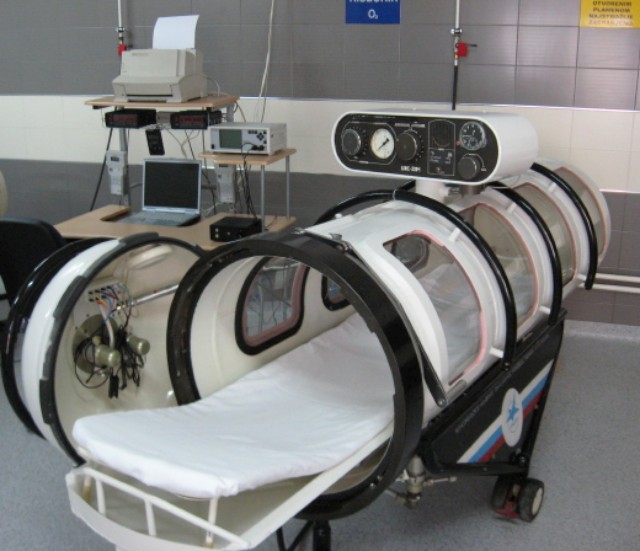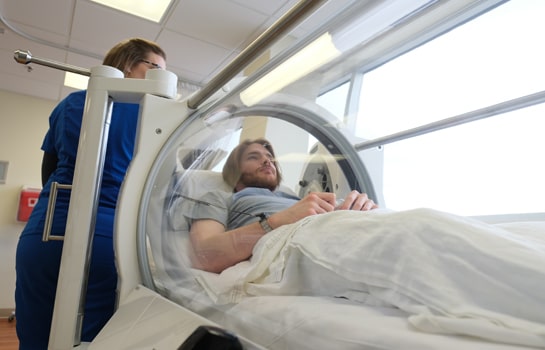How Hyperbaric Oxygen Therapy Works Wonders for Wound Healing
Hyperbaric oxygen therapy has been used for a long time to help wounds heal faster. But in recent years, more and more doctors have been using it because it has become more widely accepted and popular in mainstream medicine. The increase in the use of hyperbaric oxygen therapy is supported by its proven effectiveness in promoting faster and improved wound healing.
Let’s admit it. Whether it was some fresh wound we got while cutting onions in the kitchen or a deep, decaying injury resulting from bacterial infection, many of us have had some type of physical wound
In athletic sports, wounds are almost a given.
Consider that nearly one in three childhood injuries are associated with athletic sports. According to the National Safety Council statistics, 5- to 14-year-olds experience injuries at higher rates than any other age group. Moreover, males get injured at rates that are twice that of females.
Don’t get this wrong; wounds can be frustrating—and can significantly decrease quality of life. The following are some of the most common health effects of injuries on quality of life.
- Lack of mobility
- Discomfort
- Pain
- Social isolation
- Lack of adequate sleep
- Unpleasant odor statistics
- Lack of the ability to work
However, thanks to medical interventions, most wounds are treated relatively quickly. Almost 90% of injury victims are treated and immediately discharged. And healing with hyperbaric is increasingly becoming an essential part of this success.
What is Hyperbaric Oxygen Recovery?
Also called hyperbaric chamber injury recovery, hyperbaric oxygen recovery (HBOT) is a body treatment option where the patient breathes a very high oxygen concentration in a high-pressure chamber.
Oxygen has long been established as a catalyst in the healing and recovery of the body, including essential physiological and regenerative processes. Some of the regenerative processes associated with wound healing—for which oxygen plays an important role—include:
- The growth and development of new blood vessels, thus increasing blood flow to the tissue. Angiogenesis
- Cell proliferation occurs when cells multiply and increase in number because of cell growth and division. Body cells can then fight infections easily.
- Protein synthesis: The process by which cells make proteins. Proteins are essential for tissue repair when the wound is healing.
Therefore, doctors use hyperbaric oxygen therapy to facilitate wound-healing processes—including those mentioned above. The goal is to infuse more oxygen molecules into the body’s tissues. The process is called tissue oxygenation.
What Happens When You’re Injured?
When you get injured, an immediate inflammatory process begins as the body responds. Consequently, you’re likely to experience any or all of the following:
- Swelling around the affected area
- Warmth in the surrounding area
- Pain
- Redness of the surrounding skin
During inflammation due to some injury, the following occurs in your body—behind the scenes.
Injury and Inflammation
When you get injured, your body will try to increase blood flow to the affected part as the blood has several healing properties, including;
- Oxygen
- White blood cells
- Nutrients
Your blood vessels dilate and expand to take more blood into the area. Also, the blood vessels in the surrounding tissues become more porous and leaky. This condition happens because the body wants the essential blood components, like white blood cells and oxygen, to reach the affected cells. As a result of the increased porousness of blood vessels in the surrounding tissues, water and other body fluids percolate into the affected area, causing swelling. The rush of blood to the area and other enhanced physiological activities around the surrounding tissue will bring warmth and redness. Also, your body may fear that you’ll lose blood and set off blood clotting processes around the area. But with time, problems related to inadequate oxygen supply to the affected area can arise.
Additional Read: What Conditions Can Be Treated with Hyperbaric Oxygen Therapy
Wounds and Inadequate Oxygen Supply
After the initial inflammatory response involving the increased blood supply to the affected area, the oxygen level rises at first—due to the increase in blood supply—then falls. The reason oxygen levels fall are:
- The inflammatory response involving the movement of several immune system cells to the injured area precipitates faster consumption of oxygen, hence quicker depletion.
- Tissue damage resulting from the injury may also damage blood vessels around the area. Consequently, they may need more oxygen levels.
While the body can tolerate or even thrive in this low oxygen level environment for a while, wound healing processes may slow down and taper off when this low oxygen condition prolongs. For instance, collagen, the main structural protein that makes up the skin, can only be made with sufficient oxygen. Wounds that would take one week to heal may now take a month or more. Worse, they may become chronic—or cause sepsis due to blood infection. According to a study cited in the Lancet, sepsis is the number one cause of hospital deaths in the United States. That’s where Hyperbaric Oxygen Therapy comes in.
What Wounds Hyperbaric Oxygen Therapy Can Heal
Hyperbaric oxygen therapy is a revolutionary medical intervention that unlocks the body’s ability to heal diabetic wounds, diabetic foot ulcers, crush injuries, and chronic non-healing wounds. This treatment’s single most significant advantage is that it can stimulate the healing process quickly and effectively. It works by administering high concentrations of pure oxygen in a pressurized environment to cause a nearly twofold increase in the oxygen concentration in your blood. It helps regenerate damaged cells and form new blood vessels, thus ensuring faster healing with minimal complications. It also speeds up the formation of healthy granulation tissue around the wound, promoting better healing. With its cutting-edge technology and state-of-the-art medical intervention, hyperbaric oxygen therapy can effectively solve diabetic wounds, diabetic foot ulcers, crush injuries, and chronic non-healing wounding issues.
Hyperbaric Oxygen Therapy Increases Oxygen Levels To The Wounded Tissues

If you’ve got a wound and choose to use Hyperbaric Oxygen Therapy, you must get inside a hyperbaric chamber. A hyperbaric chamber is not like your regular surgical table. It’s not intimidating. Instead, it’s comfortable and relaxing. Inside this chamber, oxygen is at 100% concentration (compared to 21% present in the room air we breathe), and air pressure increases 1.5 to 3 times the normal atmospheric pressure (1 atm). The level of oxygen that dissolves into the tissues depends on two things:
- Oxygen concentration
- Air pressure
If these two properties are optimal, more oxygen gets into your tissues, speeding up the healing process. Also, with Hyperbaric Oxygen Therapy, the procedure is not localized to a specific area. You don’t put only the injured part inside the hyperbaric chamber. Instead, your whole body gets inside. As a result of this, it receives the benefit of increased oxygen. The increased oxygen level will also have significant effect on wound healing. It stimulates the activities of mitochondria—the cell organelles responsible for energy production. The reason this is critical is that healing is an energy-demanding process. Hyperbaric therapy and the subsequent higher levels of oxygen also:
- Stimulates the production of more stem cells required for healing
- Stimulates the body’s antimicrobial activity hence frustrating the growth of harmful bacteria
- Facilitates the growth of new blood vessels
- Promotes the growth of collagen—the protein that makes up the skin’s structure.
Other Medical Conditions and Injuries Where Hyperbaric Oxygen Therapy Be Used
The following are some of the other conditions where hyperbaric oxygen therapy may be helpful:
- Severe anemia: When the number of red blood cells in the body drop, the oxygen level in the body will likewise fall, hence the need for oxygen therapy
- Decompression sickness, common with a scuba or deep-sea divers
- Radiation injury: Radiation therapy may lead to extensive tissue damage, for which hyperbaric oxygen therapy may be useful
- Gas gangrene and clostridial myositis
- Carbon monoxide poisoning
- Chronic wounds
- Fatal soft tissue infections
- Refractory osteomyelitis: Infection of the bone marrow
- Thermal burns
- Sudden deafness
- Sudden vision loss
Hyperbaric oxygen therapy for athletes helps them reduce their recovery time or just to improve their general well-being. Other amazing benefits of HBOT for athletes include more energy and mental clarity. NBA star LeBron James is among athletes who practice healing with hyperbaric oxygen therapy, especially to hasten recovery. A tweet of him in a hyperbaric oxygen chamber was widely shared on the internet.
Additional Read: The Benefits of HBOT for Post-Traumatic Stress Disorder
At what point in a medical treatment plan is it recommended to undergo Hyperbaric Oxygen Therapy?
It is typically recommended when standard treatments have been exhausted, and effects are still limited in improving the patient’s health. Poor circulation, slow healing processes, and other conditions can be addressed when this therapy is utilized. HBOT involves surrounding a person’s body with 100% oxygen inside a pressurized chamber to ensure oxygen gets absorbed into the bloodstream faster and more efficiently than conventional breathing techniques. In cases like decompression illness, carbon monoxide poisoning, recovery following surgery, and chronic conditions like diabetes or ulcers, becoming a candidate for hyperbaric oxygen may be advised by your healthcare provider to fully maximize the effects of treatment in helping you improve your overall health condition.
Hyperbaric Oxygen Therapy: What You Should Expect
What can you expect and be prepared for when considering hyperbaric oxygen therapy?
- Expect to be in a resting position similar to when you’re relaxing on your bed.
- You can expect to see it all around you.
- Your hearing could experience a slight pressure similar to that experienced on a flight. In most cases, this is nothing to worry about. Still, if you feel ear pain, don’t hesitate to tell the technician who’s doing the therapy.
- Hyperbaric oxygen therapy is not a one-off treatment session. It can extend to two months, 4-5 days a week.
- A single hyperbaric therapy session may last about two hours.
- After the procedure, the doctor will take your blood pressure, pulse, and blood sugar level if you have diabetes.
- You can leave immediately after the session.
Do You Want To Use Hyperbaric Therapy for Healing or General Well-being?
Wounds and injuries can make us lose days and months of income-generating labor. Plus, not to mention:
- The pain— that makes us grimace and weep.
- Isolation and confinement keep us away from friends and social events; and
- Frustration and anxiety when your wound doesn’t heal as quickly as you’d want
But time—contrary to what we’ve been told—may not heal all wounds. Hyperbaric medicine can help you recover faster to quickly resume chasing your dreams and living your life to the fullest. At NexGen Hyperbaric, we make hyperbaric oxygen therapy technology accessible to people who need it to help needy patients. Accredited by the Undersea Hyperbaric and Medical Society, we have state-of-the-art facilities, equipment, experienced staff, rigorous training, and unmatched patient care and operational safety standards. Did you get a wound that’s taking too long to heal? Contact us and learn how NextGen Hyperbaric can help you heal.
Additional Read- HYPERBARIC OXYGEN TREATMENT CLINIC: 9 ESSENTIAL FACTORS TO CONSIDER WHEN SELECTING HBOT CLINIC




Leave a Reply
Want to join the discussion?Feel free to contribute!